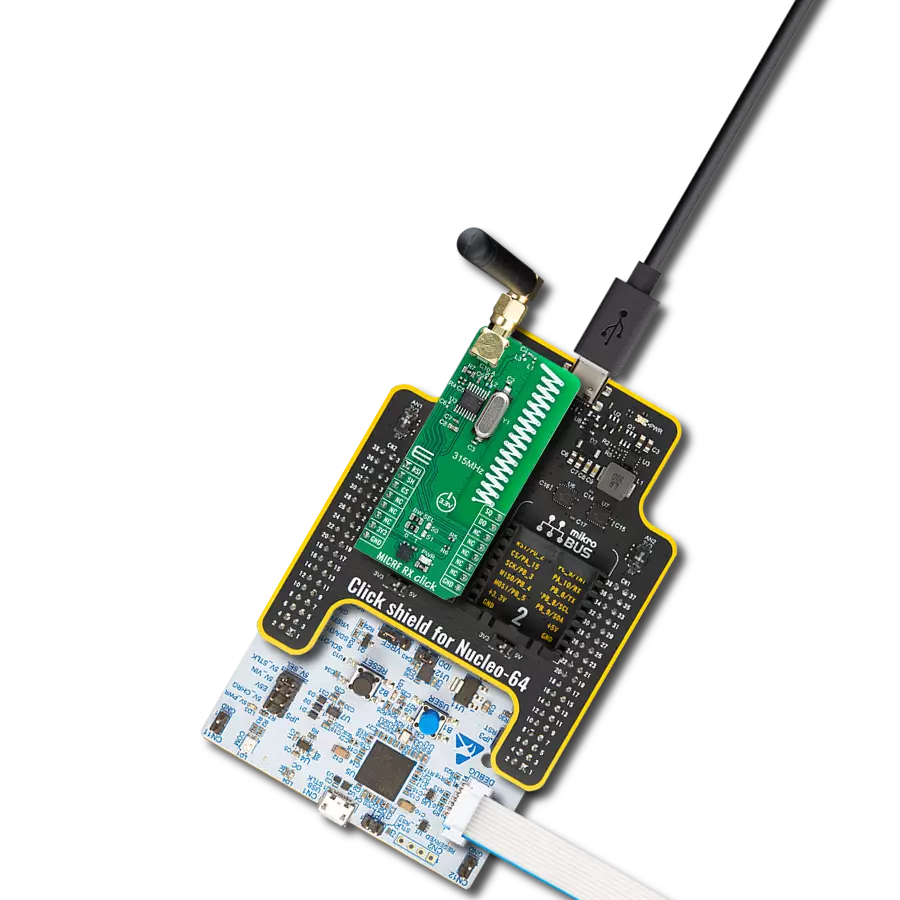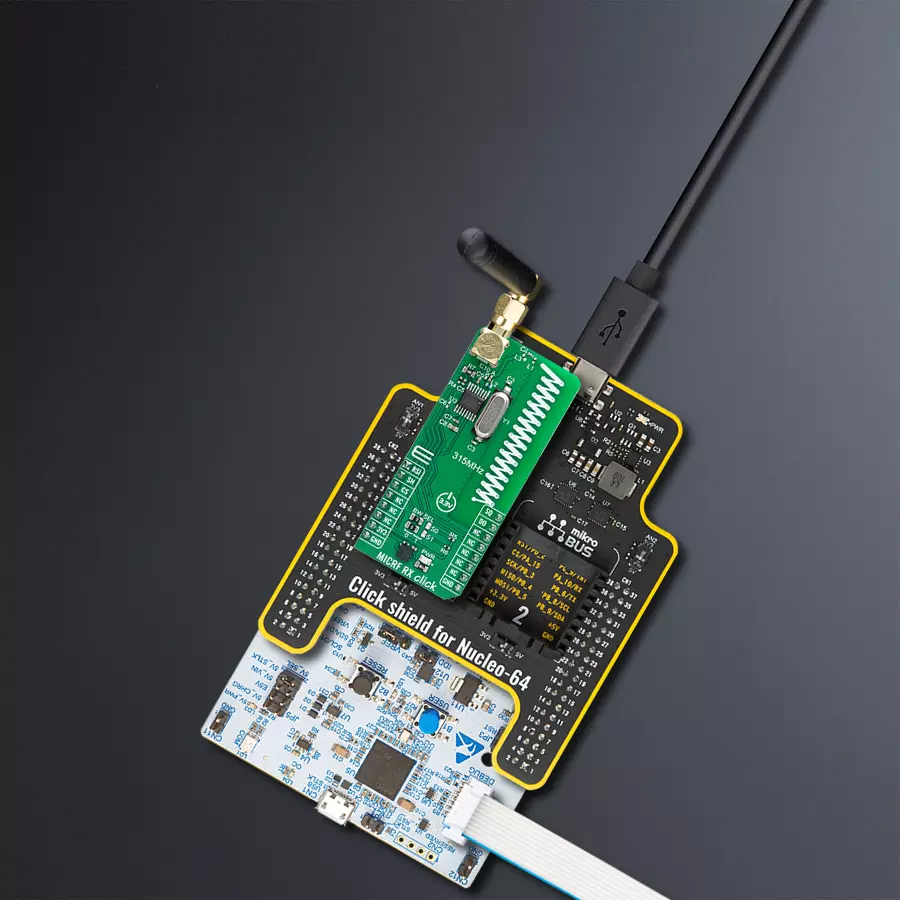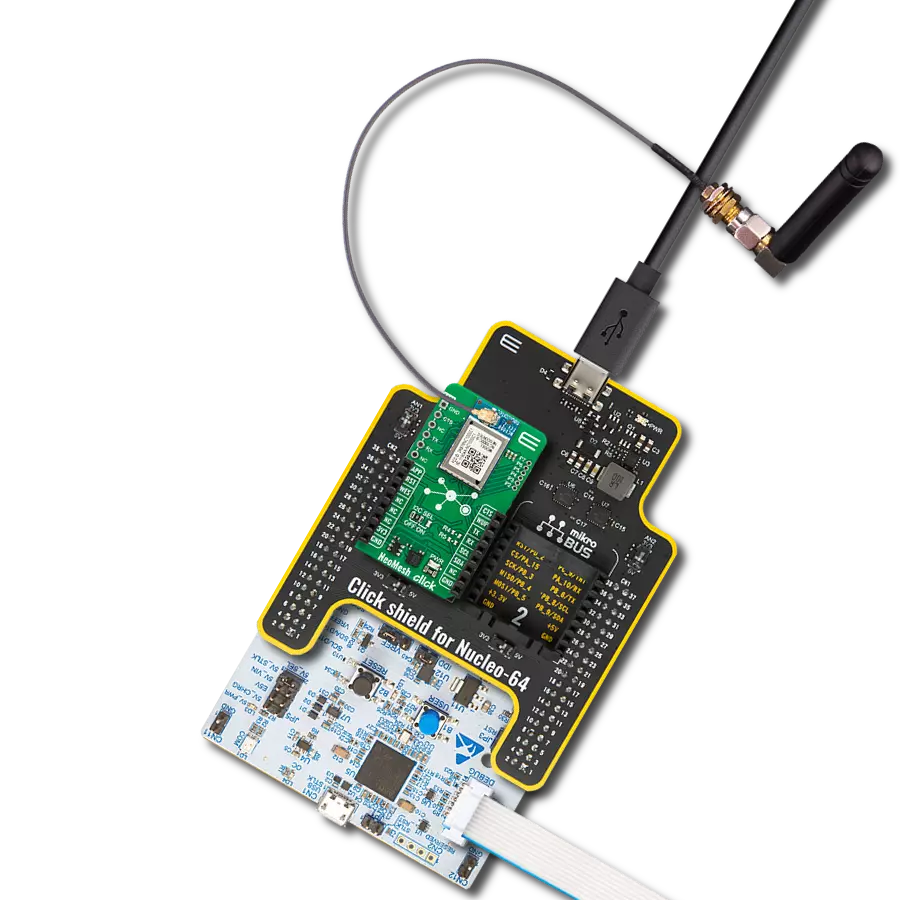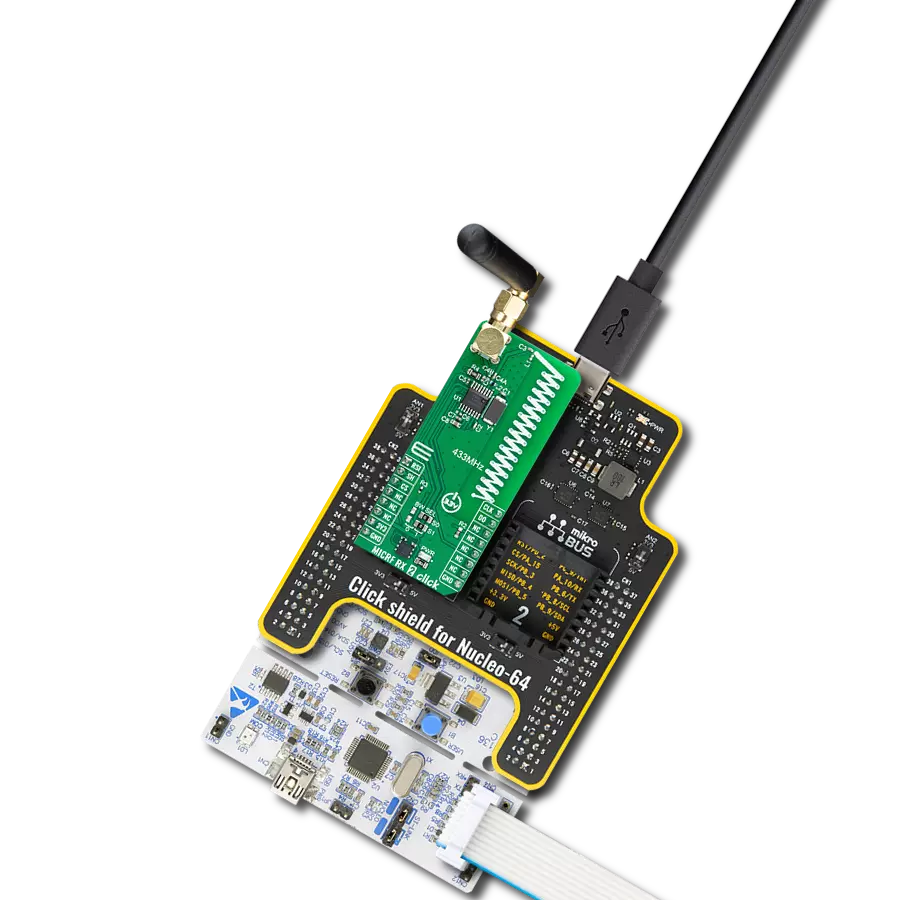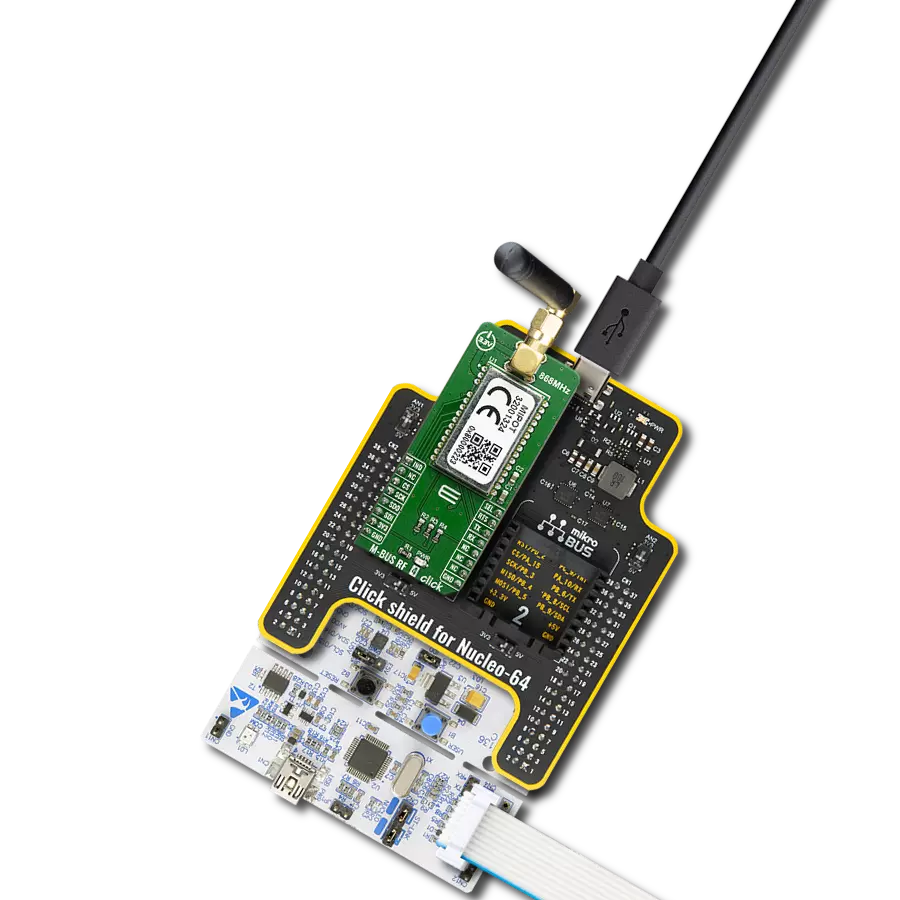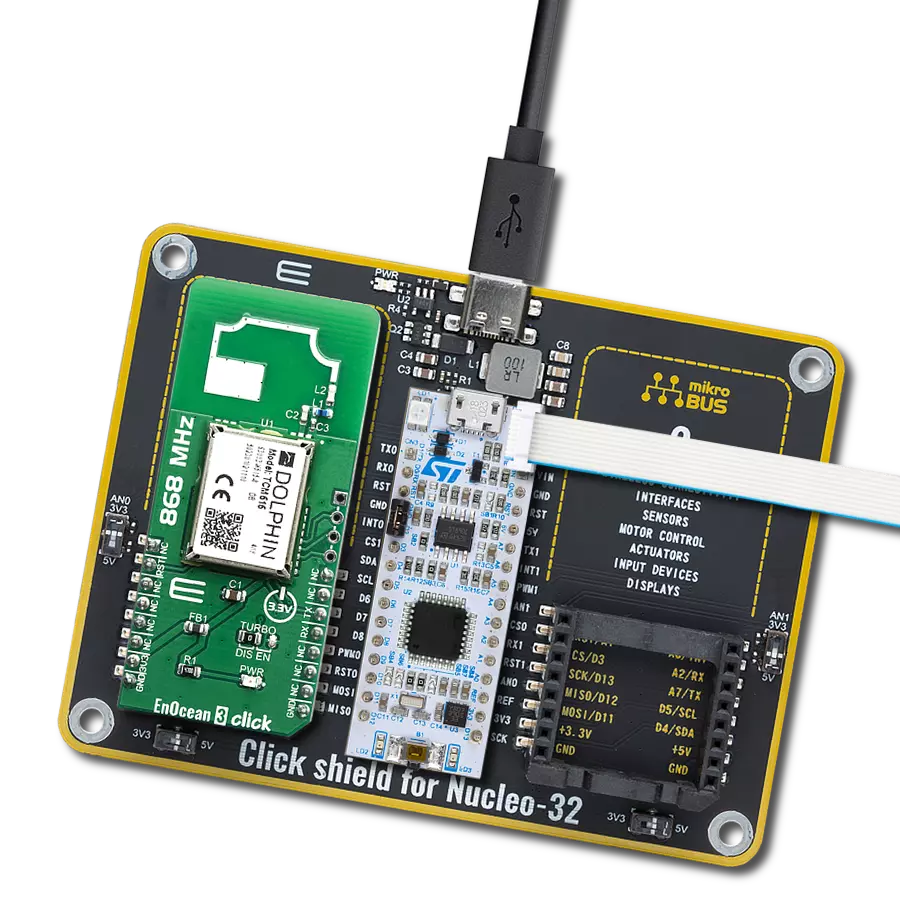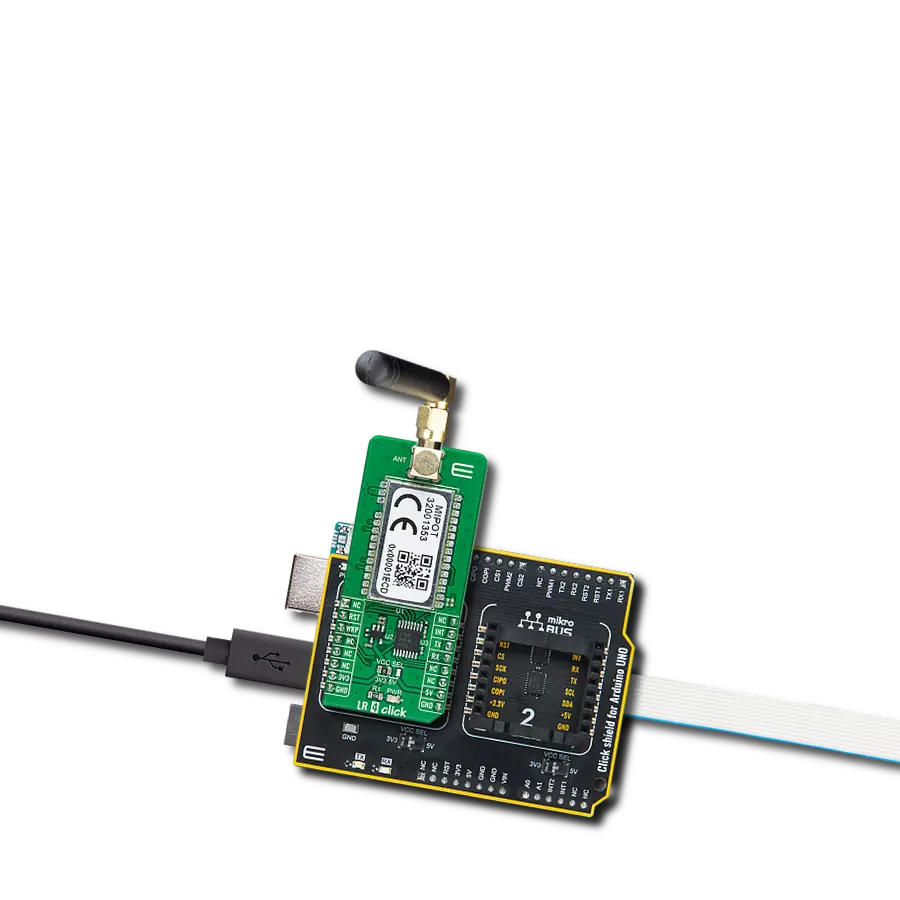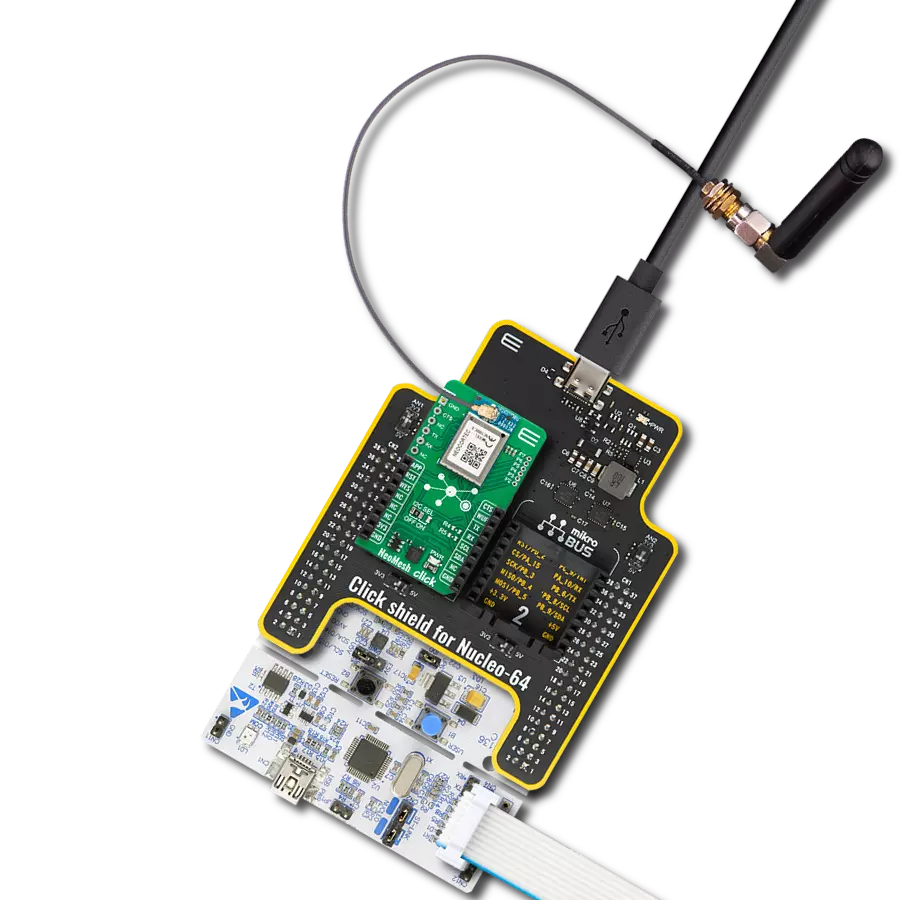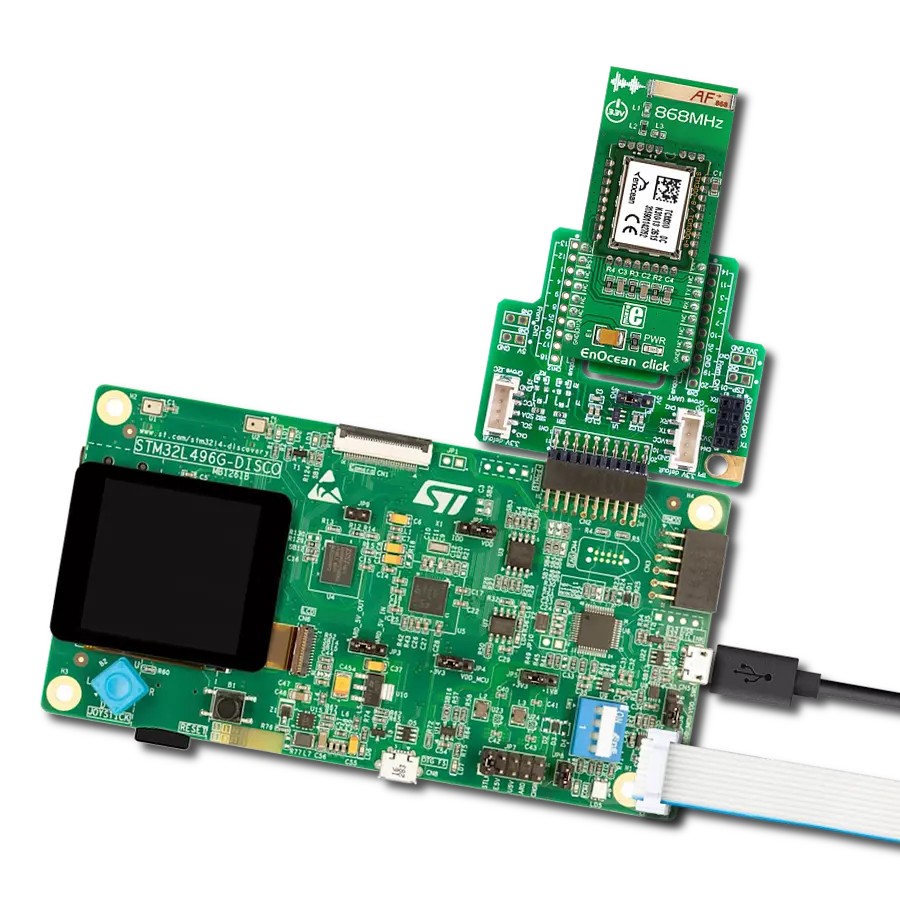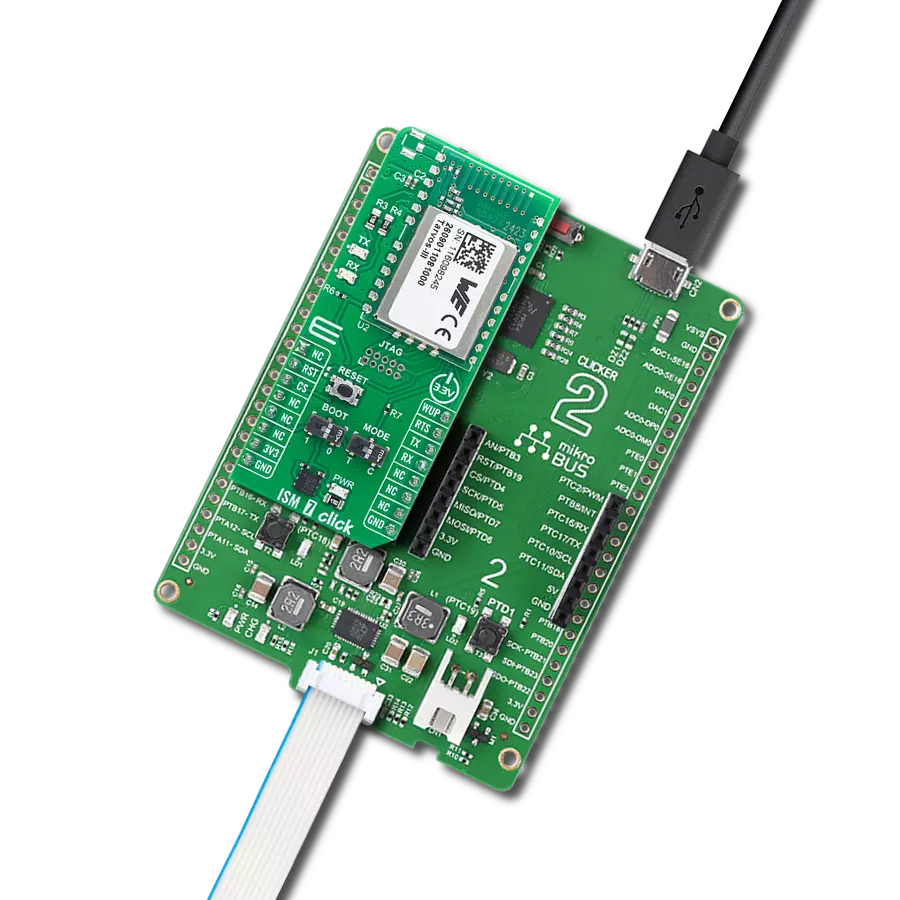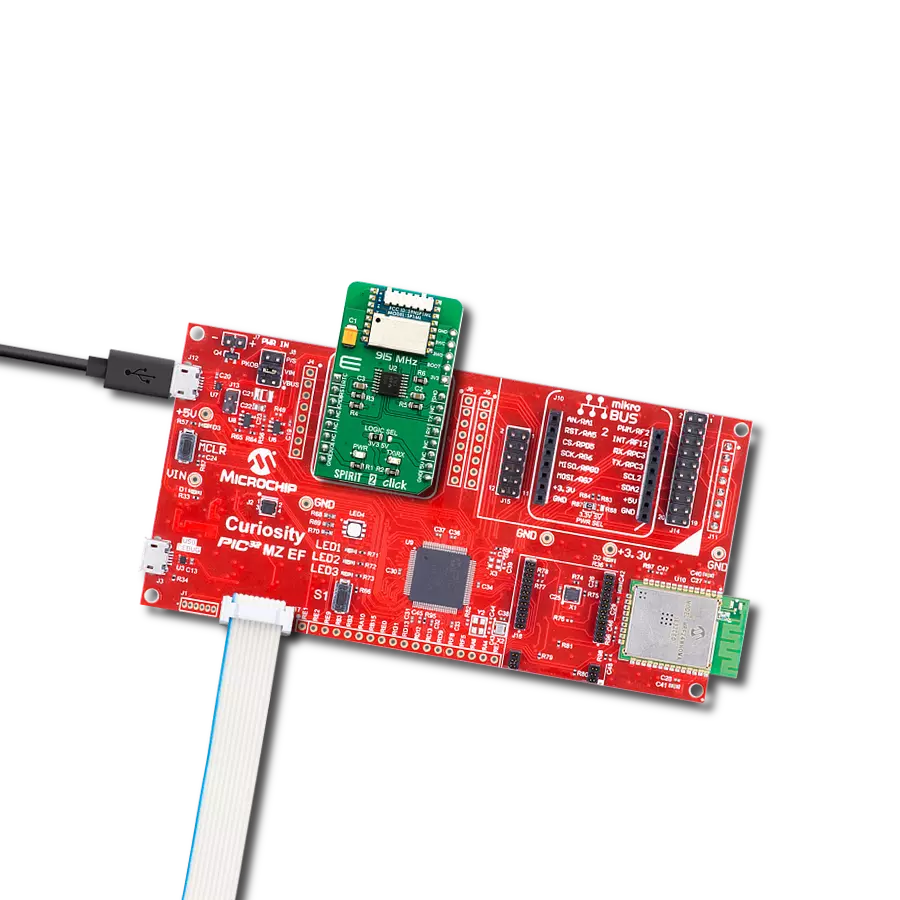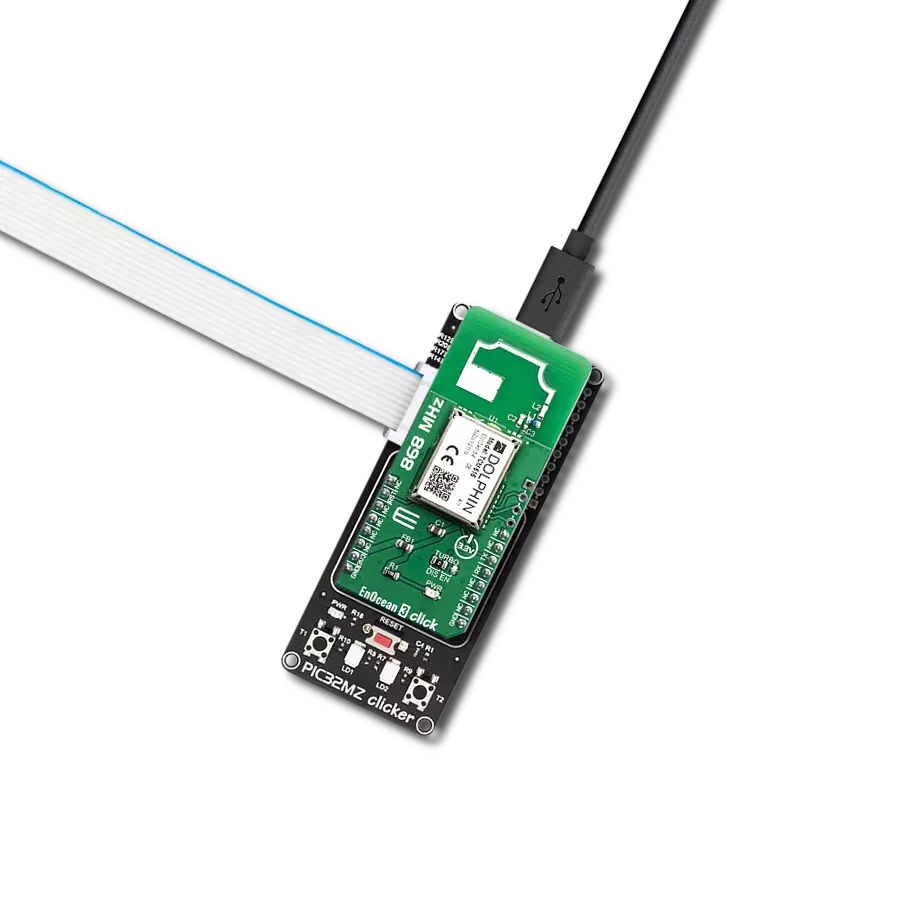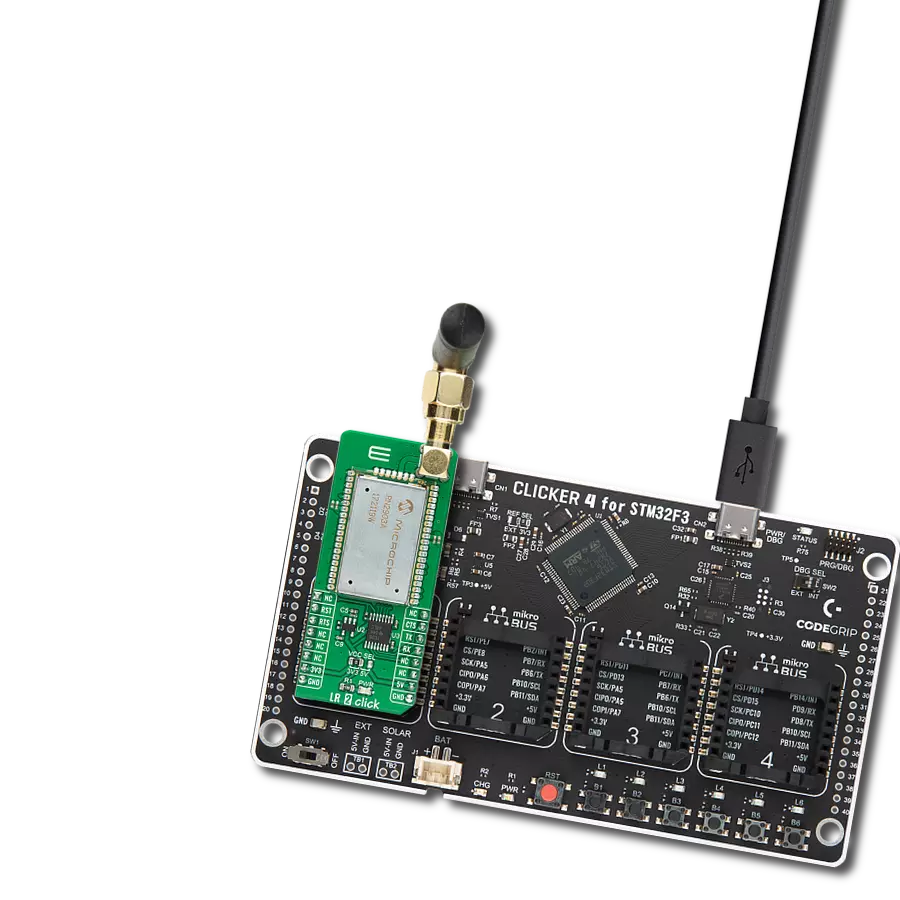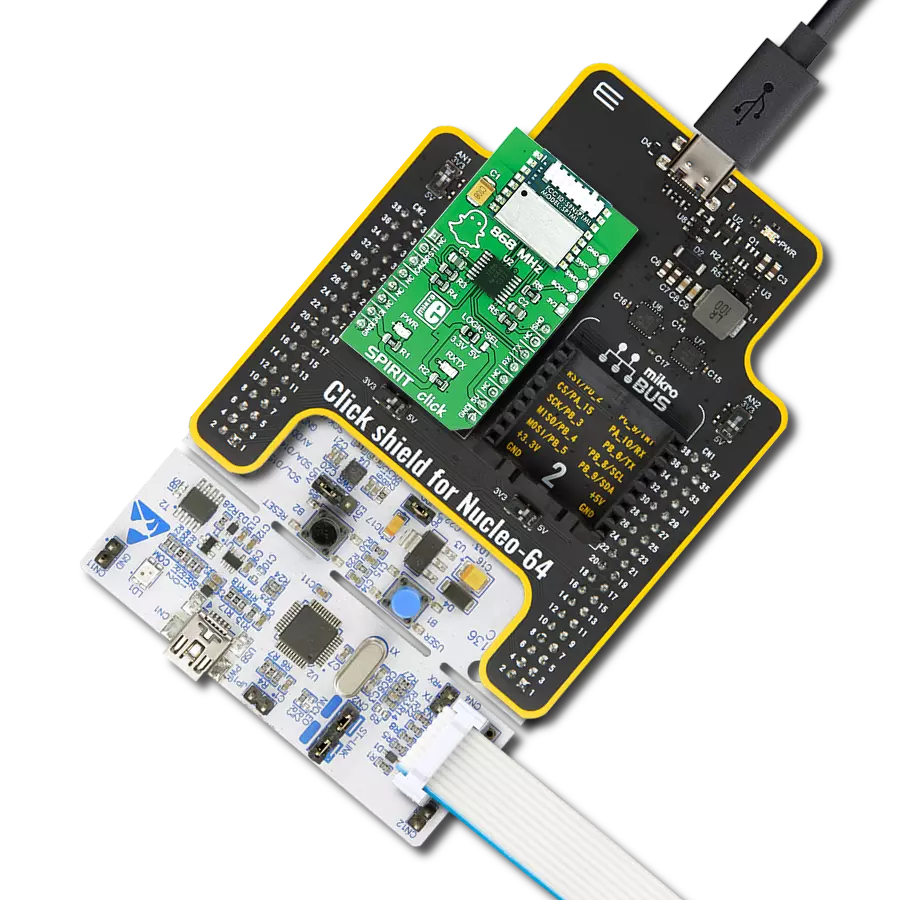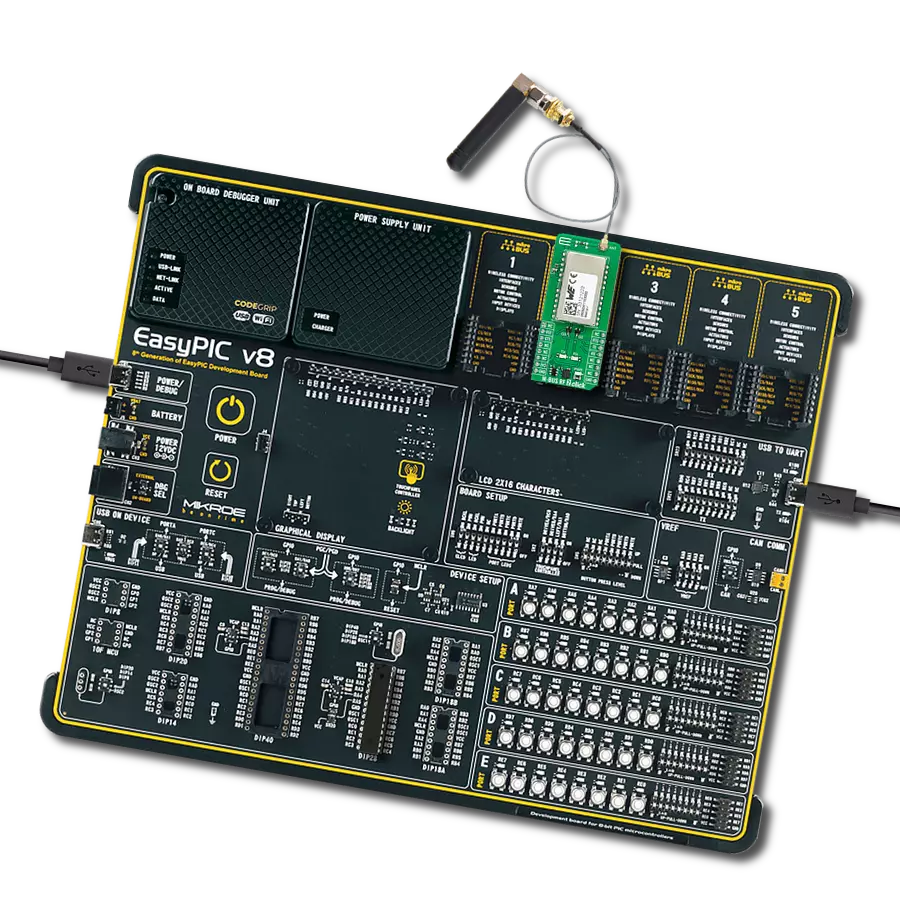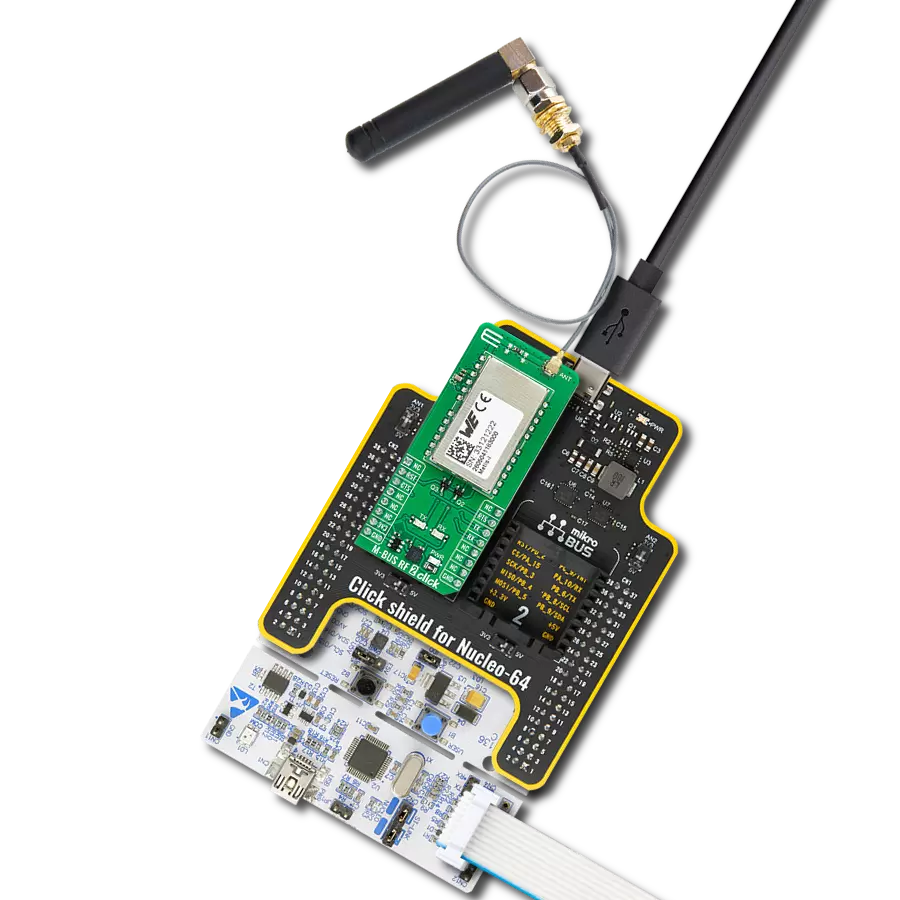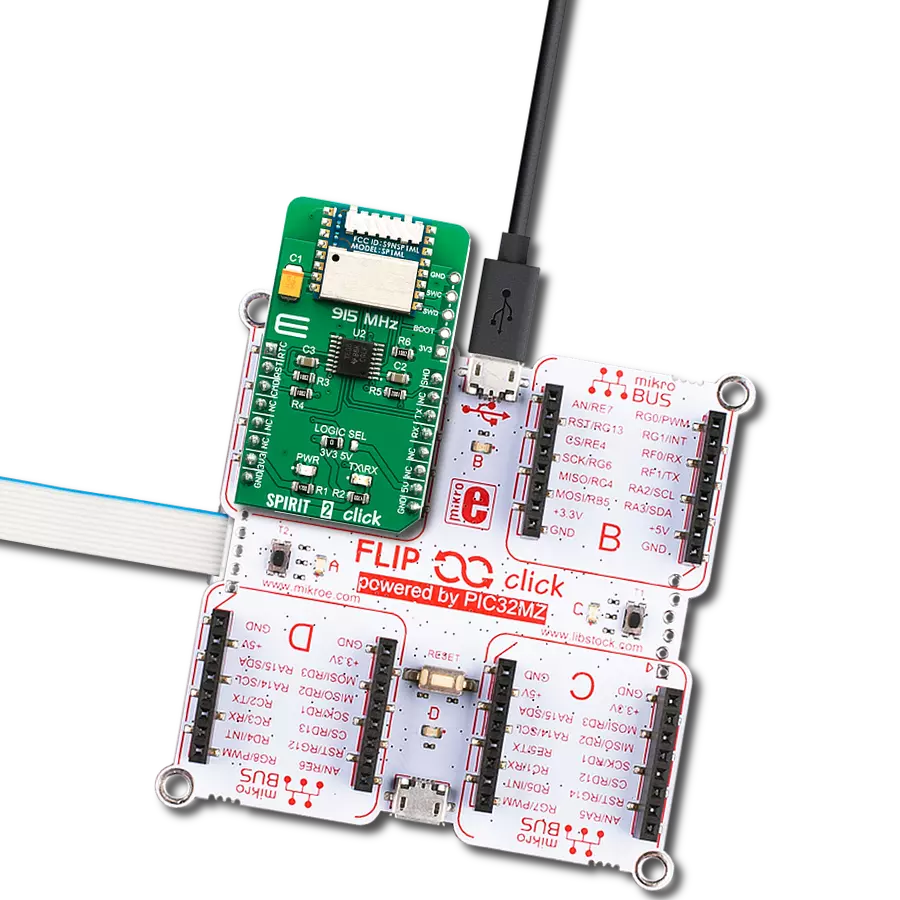开发解决方案,使各种设备的远程控制成为可能,例如家庭自动化系统或工业机械。
A
A
硬件概览
它是如何工作的?
MICRF RX Click 基于来自Microchip的MICRF220,这是一款带有RSSI和静噪的ASK/OOK接收器。这款超外差、抗镜像 RF 接收器经过设计,只需一个晶体即可运行,在本例中是板载的9.81563MHz,并且只需要一组最少的外部元件。它适用于各种应用,例如低功耗远程无钥匙进入(RKE)、轮胎压力监测系统(TPMS)和远程操作系统。在性能方面,MICRF220 以-110dBm的灵敏度、1kbps和0.1%的比特错误率(BER)脱颖而出,并配备了四种可选择的解调器滤波器带宽,范围从1170Hz到
在9400Hz。通过将 BW SEL 跳线放置相应的位置(0或1),可以选择滤波器带宽,根据附带的 MICRF220 数据表中的真值表(Table 2.)选择相应的频率。此功能允许设备容纳高达14.4kbps的比特率(从1.8kbps到14.4kbps)。它在来自mikroBUS™电源轨的3.3V供电下运行,经过优化以进行315MHz操作,典型供电电流为4.3mA。此外,MICRF220 具有低功耗关机模式,通过 SH 引脚可控制,将供电电流降低到令人印象深刻的0.1µA。它还具有一个通过 SQ 引脚访问的静噪功能,可最小化 DO 引脚上的数据
输出活动,直到检测到有效比特而不影响接收机灵敏度。该板还集成了一个 RSI 引脚,用于指示接收信号强度。对于天线配置,该板允许使用专门调谐到315MHz的板载PCB天线或通过SMA连接器使用外部天线,通过调节SMA连接器附近位置 A 到位置 B 的电容器进行选择。此 Click board™ 只能使用3.3V逻辑电压级别。在使用具有不同逻辑电平的MCU之前,板必须执行适当的逻辑电压级别转换。此外,它配备了一个包含函数和示例代码的库,可用作进一步开发的参考。
功能概述
开发板
Nucleo-64 搭载 STM32G431RB MCU 提供了一种经济高效且灵活的平台,供开发者探索新想法并原型设计他们的项目。该板利用 STM32 微控制器的多功能性,使用户能够为他们的项目选择最佳的性能与功耗平衡。它配备了 LQFP64 封装的 STM32 微控制器,并包含了如用户 LED(同时作为 ARDUINO® 信号)、用户和复位按钮,以及 32.768kHz 晶体振荡器用于精确的计时操作等基本组件。Nucleo-64 板设计考虑到扩展性和灵活性,它特有的 ARDUINO® Uno
V3 扩展连接器和 ST morpho 扩展引脚头,提供了对 STM32 I/O 的完全访问,以实现全面的项目整合。电源供应选项灵活,支持 ST-LINK USB VBUS 或外部电源,确保在各种开发环境中的适应性。该板还配备了一个具有 USB 重枚举功能的板载 ST-LINK 调试器/编程器,简化了编程和调试过程。此外,该板设计旨在简化高级开发,它的外部 SMPS 为 Vcore 逻辑供电提供高效支持,支持 USB 设备全速或 USB SNK/UFP 全速,并内置加密功能,提升了项目的功效
和安全性。通过外部 SMPS 实验的专用连接器、 用于 ST-LINK 的 USB 连接器以及 MIPI® 调试连接器,提供了更多的硬件接口和实验可能性。开发者将通过 STM32Cube MCU Package 提供的全面免费软件库和示例得到广泛支持。这些,加上与多种集成开发环境(IDE)的兼容性,包括 IAR Embedded Workbench®、MDK-ARM 和 STM32CubeIDE,确保了流畅且高效的开发体验,使用户能够充分利用 Nucleo-64 板在他们的项目中的能力。
微控制器概述
MCU卡片 / MCU
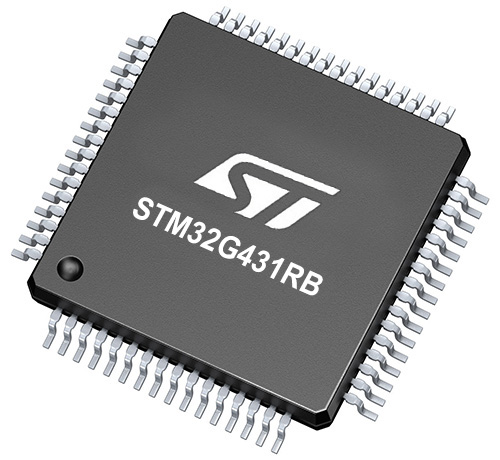
建筑
ARM Cortex-M4
MCU 内存 (KB)
128
硅供应商
STMicroelectronics
引脚数
64
RAM (字节)
32k
你完善了我!
配件
Click Shield for Nucleo-64 配备了两个专有的 mikroBUS™ 插座,使得所有的 Click board™ 设备都可以轻松地与 STM32 Nucleo-64 开发板连接。这样,Mikroe 允许其用户从不断增长的 Click boards™ 范围中添加任何功能,如 WiFi、GSM、GPS、蓝牙、ZigBee、环境传感器、LED、语音识别、电机控制、运动传感器等。您可以使用超过 1537 个 Click boards™,这些 Click boards™ 可以堆叠和集成。STM32 Nucleo-64 开发板基于 64 引脚封装的微控制器,采用 32 位 MCU,配备 ARM Cortex M4 处理器,运行速度为 84MHz,具有 512Kb Flash 和 96KB SRAM,分为两个区域,顶部区域代表 ST-Link/V2 调试器和编程器,而底部区域是一个实际的开发板。通过 USB 连接方便地控制和供电这些板子,以便直接对 Nucleo-64 开发板进行编程和高效调试,其中还需要额外的 USB 线连接到板子上的 USB 迷你接口。大多数 STM32 微控制器引脚都连接到了板子左右边缘的 IO 引脚上,然后连接到两个现有的 mikroBUS™ 插座上。该 Click Shield 还有几个开关,用于选择 mikroBUS™ 插座上模拟信号的逻辑电平和 mikroBUS™ 插座本身的逻辑电压电平。此外,用户还可以通过现有的双向电平转换器,使用任何 Click board™,无论 Click board™ 是否在 3.3V 或 5V 逻辑电压电平下运行。一旦将 STM32 Nucleo-64 开发板与我们的 Click Shield for Nucleo-64 连接,您就可以访问数百个工作于 3.3V 或 5V 逻辑电压电平的 Click boards™。
使用的MCU引脚
mikroBUS™映射器
“仔细看看!”
Click board™ 原理图

一步一步来
项目组装
软件支持
库描述
该库包含 MICRF RX Click 驱动程序的 API。
关键功能:
micrfrx_enable_device- 此函数通过将SHD引脚设置为低逻辑状态来启用设备。micrfrx_wait_ready- 此函数等待所有训练字节到达,表示数据已准备好。micrfrx_read_packet- 此函数仅在成功接收MICRFRX_PREAMBLE字节时读取数据包并将其存储在packet_buf中。
开源
代码示例
完整的应用程序代码和一个现成的项目可以通过NECTO Studio包管理器直接安装到NECTO Studio。 应用程序代码也可以在MIKROE的GitHub账户中找到。
/*!
* @file main.c
* @brief MICRF RX Click Example.
*
* # Description
* This example demonstrates the use of MICRF RX Click board by reading and parsing
* packet messages received from the transmitter.
*
* The demo application is composed of two sections :
*
* ## Application Init
* Initializes the driver and enables the device and squelch mode.
*
* ## Application Task
* Waits for a data ready indication, then reads all packet data, verifies the CRC
* bytes in a packet, and displays its data as well as the RSSI value on the USB UART.
*
* @note
* The MICRF TX Click board is a compatible transmitter for the MICRF RX Click.
* Here are a few steps for troubleshooting if you are experiencing issues running
* this example:
* - Make sure the MICRF TX Click is set to ASK mode with on-board jumpers.
* - Check the MCU clock configuration, use an external oscillator instead of the MCU's
* internal one for better accuracy on manchester data rate delay.
* - Measure the actual data rate on the data line and adjust the MICRFRX_MAN_BIT_LEN_US
* value accordingly.
*
* @author Stefan Filipovic
*
*/
#include "board.h"
#include "log.h"
#include "micrfrx.h"
#define MICRFRX_PREAMBLE 0x5AA5 /**< Packet preamble word. */
static micrfrx_t micrfrx; /**< MICRF RX Click driver object. */
static log_t logger; /**< Logger object. */
static uint8_t packet_buf[ MICRFRX_MAX_DATA_LEN + 5 ] = { 0 }; /**< Packet buffer. */
/**
* @brief MICRF RX wait ready function.
* @details This function waits for all training bytes to arrive which indicates data ready.
* @param[in] ctx : Click context object.
* See #micrfrx_t object definition for detailed explanation.
* @return None.
* @note None.
*/
static void micrfrx_wait_ready ( micrfrx_t *ctx );
/**
* @brief MICRF RX read packet function.
* @details This function reads data packet and stores it in a packet_buf only if
* the MICRFRX_PREAMBLE bytes are received successfully.
* @param[in] ctx : Click context object.
* See #micrfrx_t object definition for detailed explanation.
* @return Number of data bytes stored in a packet_buf.
* @note The expected packet format is as follows (MSB first, manchester IEEE 802.3):
* TRAINING_BYTES (at least two bytes of 0xAA), PREABMLE, LEN, DATA_IN, CRC16 (calculated
* from whole packet excluding training bytes). Training bytes are excluded from packet_buf.
* This function must be called immediately after calling micrfrx_wait_ready.
*/
static uint8_t micrfrx_read_packet ( micrfrx_t *ctx );
/**
* @brief Reflect bits.
* @details This function reflects a desired number of bits in data.
* @return Reflected data.
* @note None.
*/
static uint16_t micrfrx_reflect_bits( uint16_t data_in, uint8_t len );
/**
* @brief CRC-16/MAXIM calculation for CRC16 function.
* @details This function calculates CRC16 with parameteres:
* @li @c Width 16 bit
* @li @c Polynomial 0x8005 ( x16 + x15 + x2 + x0 )
* @li @c Initialization 0x0000
* @li @c Reflect input True
* @li @c Reflect output True
* @li @c Final Xor 0xFFFF
* @li @c Example { 69, 00 } - 0xAFD1
* @param[in] data_buf : Array of bytes to calculate crc from.
* @param[in] len : Number of bytes to calculate crc from.
* @return Calculated CRC.
* @note None.
*/
static uint16_t micrfrx_calculate_crc16 ( uint8_t *data_buf, uint16_t len );
void application_init ( void )
{
log_cfg_t log_cfg; /**< Logger config object. */
micrfrx_cfg_t micrfrx_cfg; /**< Click config object. */
/**
* Logger initialization.
* Default baud rate: 115200
* Default log level: LOG_LEVEL_DEBUG
* @note If USB_UART_RX and USB_UART_TX
* are defined as HAL_PIN_NC, you will
* need to define them manually for log to work.
* See @b LOG_MAP_USB_UART macro definition for detailed explanation.
*/
LOG_MAP_USB_UART( log_cfg );
log_init( &logger, &log_cfg );
log_info( &logger, " Application Init " );
// Click initialization.
micrfrx_cfg_setup( &micrfrx_cfg );
MICRFRX_MAP_MIKROBUS( micrfrx_cfg, MIKROBUS_1 );
if ( DIGITAL_OUT_UNSUPPORTED_PIN == micrfrx_init( &micrfrx, &micrfrx_cfg ) )
{
log_error( &logger, " Communication init." );
for ( ; ; );
}
micrfrx_enable_squelch ( &micrfrx );
micrfrx_enable_device ( &micrfrx );
log_info( &logger, " Application Task " );
}
void application_task ( void )
{
static float rssi_v = 0;
static uint8_t packet_len = 0;
static uint8_t msg_cnt = 0;
static uint16_t crc = 0;
log_printf( &logger, "\r\n Waiting for data ready...\r\n" );
micrfrx_wait_ready ( &micrfrx );
packet_len = micrfrx_read_packet ( &micrfrx );
if ( packet_len )
{
micrfrx_read_rssi_voltage ( &micrfrx, &rssi_v );
crc = ( ( uint16_t ) packet_buf[ packet_len - 2 ] << 8 ) | packet_buf[ packet_len - 1 ];
if ( crc == micrfrx_calculate_crc16 ( packet_buf, packet_len - 2 ) )
{
log_printf( &logger, " Received message: " );
for ( msg_cnt = 0; msg_cnt < packet_buf[ 2 ]; msg_cnt++ )
{
log_printf( &logger, "%c", ( uint16_t ) packet_buf[ msg_cnt + 3 ] );
}
log_printf( &logger, "\r\n RSSI: %.1f dBm\r\n", MICRFRX_RSSI_V_TO_DBM ( rssi_v ) );
}
}
Delay_ms ( 100 );
}
int main ( void )
{
/* Do not remove this line or clock might not be set correctly. */
#ifdef PREINIT_SUPPORTED
preinit();
#endif
application_init( );
for ( ; ; )
{
application_task( );
}
return 0;
}
static void micrfrx_wait_ready ( micrfrx_t *ctx )
{
uint16_t time_cnt = 0;
uint16_t training_high_cnt = 0;
uint16_t training_low_cnt = 0;
// Loop until at least two 0xAA bytes of training data is detected
for ( ; ; )
{
// Measure time in steps of MICRFRX_MAN_BIT_LEN_US / 40 for high signal
for ( time_cnt = 0; micrfrx_get_data_pin ( ctx ); time_cnt++ )
{
Delay_us ( MICRFRX_MAN_BIT_LEN_US / 40 );
}
if ( time_cnt > 30 )
{
// Increment training_high_cnt if signal width is at least 75% of MICRFRX_MAN_BIT_LEN_US
training_high_cnt++;
}
else
{
// Reset counters if any invalid signal is detected
training_high_cnt = 0;
training_low_cnt = 0;
}
// Measure time in steps of MICRFRX_MAN_BIT_LEN_US / 40 for low signal
for ( time_cnt = 0; ( training_high_cnt > 0 ) && !micrfrx_get_data_pin ( ctx ); time_cnt++ )
{
Delay_us ( MICRFRX_MAN_BIT_LEN_US / 40 );
}
if ( time_cnt > 30 )
{
// Increment training_low_cnt if signal width is at least 75% of MICRFRX_MAN_BIT_LEN_US
training_low_cnt++;
}
else if ( ( training_high_cnt >= 8 ) && ( training_high_cnt == ( training_low_cnt + 1 ) ) )
{
// At least two 0xAA bytes are detected ending with shorter low signal, so break the loop here.
// Waiting for 12.5% of MICRFRX_MAN_BIT_LEN_US as an offset for packet reading.
Delay_us ( MICRFRX_MAN_BIT_LEN_US / 8 );
break;
}
}
}
static uint8_t micrfrx_read_packet ( micrfrx_t *ctx )
{
uint8_t byte_cnt = 0;
uint8_t bit_cnt = 0;
// Loop until all data bytes are received or a bad PREAMBLE word is detected
for ( ; ; )
{
if ( !micrfrx_get_data_pin ( ctx ) )
{
// Store data in packet_buf in manchester IEEE 802.3 format, MSB first
packet_buf[ byte_cnt ] |= ( 0x80 >> bit_cnt );
}
if ( 8 == ++bit_cnt )
{
// Reset bit counter and increment byte counter if 8 bits are received
bit_cnt = 0;
byte_cnt++;
}
if ( 2 == byte_cnt )
{
// Two bytes are received, check PREAMBLE word
if ( MICRFRX_PREAMBLE != ( ( ( uint16_t ) packet_buf[ 0 ] << 8 ) | packet_buf[ 1 ] ) )
{
byte_cnt = 0;
break;
}
}
else if ( ( packet_buf[ 2 ] + 5 ) == byte_cnt )
{
// Break the loop if all packet data are received (PREAMBLE + DATA_LEN + DATA + CRC)
break;
}
// Move to the next manchester clock high state by delaying for MICRFRX_MAN_BIT_LEN_US
Delay_us ( MICRFRX_MAN_BIT_LEN_US );
}
return byte_cnt;
}
static uint16_t micrfrx_reflect_bits( uint16_t data_in, uint8_t len )
{
uint16_t data_out = 0;
for ( uint16_t cnt = 0; cnt < len; cnt++ )
{
data_out |= ( ( data_in >> cnt ) & 1 ) << ( len - cnt - 1 );
}
return data_out;
}
static uint16_t micrfrx_calculate_crc16( uint8_t *data_buf, uint16_t len )
{
uint16_t crc16 = 0x0000;
for ( uint16_t cnt = 0; cnt < len; cnt++ )
{
crc16 ^= ( micrfrx_reflect_bits( data_buf[ cnt ], 8 ) << 8 );
for ( uint8_t bit_cnt = 0; bit_cnt < 8; bit_cnt++ )
{
if ( crc16 & 0x8000 )
{
crc16 = ( crc16 << 1 ) ^ 0x8005;
}
else
{
crc16 <<= 1;
}
}
}
return micrfrx_reflect_bits( crc16, 16 ) ^ 0xFFFF;
}
// ------------------------------------------------------------------------ END
额外支持
资源
类别:1GHz以下收发器
